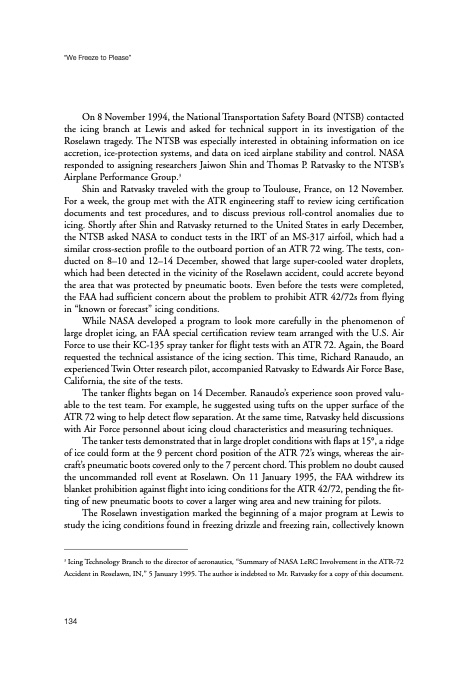
PDF Publication Title:
Text from PDF Page: 145
“We Freeze to Please” On 8 November 1994, the National Transportation Safety Board (NTSB) contacted the icing branch at Lewis and asked for technical support in its investigation of the Roselawn tragedy. The NTSB was especially interested in obtaining information on ice accretion, ice-protection systems, and data on iced airplane stability and control. NASA responded to assigning researchers Jaiwon Shin and Thomas P. Ratvasky to the NTSB’s Airplane Performance Group.3 Shin and Ratvasky traveled with the group to Toulouse, France, on 12 November. For a week, the group met with the ATR engineering staff to review icing certification documents and test procedures, and to discuss previous roll-control anomalies due to icing. Shortly after Shin and Ratvasky returned to the United States in early December, the NTSB asked NASA to conduct tests in the IRT of an MS-317 airfoil, which had a similar cross-section profile to the outboard portion of an ATR 72 wing. The tests, con- ducted on 8–10 and 12–14 December, showed that large super-cooled water droplets, which had been detected in the vicinity of the Roselawn accident, could accrete beyond the area that was protected by pneumatic boots. Even before the tests were completed, the FAA had sufficient concern about the problem to prohibit ATR 42/72s from flying in “known or forecast” icing conditions. While NASA developed a program to look more carefully in the phenomenon of large droplet icing, an FAA special certification review team arranged with the U.S. Air Force to use their KC-135 spray tanker for flight tests with an ATR 72. Again, the Board requested the technical assistance of the icing section. This time, Richard Ranaudo, an experienced Twin Otter research pilot, accompanied Ratvasky to Edwards Air Force Base, California, the site of the tests. The tanker flights began on 14 December. Ranaudo’s experience soon proved valu- able to the test team. For example, he suggested using tufts on the upper surface of the ATR 72 wing to help detect flow separation. At the same time, Ratvasky held discussions with Air Force personnel about icing cloud characteristics and measuring techniques. The tanker tests demonstrated that in large droplet conditions with flaps at 15°, a ridge of ice could form at the 9 percent chord position of the ATR 72’s wings, whereas the air- craft’s pneumatic boots covered only to the 7 percent chord. This problem no doubt caused the uncommanded roll event at Roselawn. On 11 January 1995, the FAA withdrew its blanket prohibition against flight into icing conditions for the ATR 42/72, pending the fit- ting of new pneumatic boots to cover a larger wing area and new training for pilots. The Roselawn investigation marked the beginning of a major program at Lewis to study the icing conditions found in freezing drizzle and freezing rain, collectively known 3 Icing Technology Branch to the director of aeronautics, “Summary of NASA LeRC Involvement in the ATR-72 Accident in Roselawn, IN,” 5 January 1995. The author is indebted to Mr. Ratvasky for a copy of this document. 134PDF Image | History of NASA Icing Research Tunnel

PDF Search Title:
History of NASA Icing Research TunnelOriginal File Name Searched:
sp4226.pdfDIY PDF Search: Google It | Yahoo | Bing
NFT (Non Fungible Token): Buy our tech, design, development or system NFT and become part of our tech NFT network... More Info
IT XR Project Redstone NFT Available for Sale: NFT for high tech turbine design with one part 3D printed counter-rotating energy turbine. Be part of the future with this NFT. Can be bought and sold but only one design NFT exists. Royalties go to the developer (Infinity) to keep enhancing design and applications... More Info
Infinity Turbine IT XR Project Redstone Design: NFT for sale... NFT for high tech turbine design with one part 3D printed counter-rotating energy turbine. Includes all rights to this turbine design, including license for Fluid Handling Block I and II for the turbine assembly and housing. The NFT includes the blueprints (cad/cam), revenue streams, and all future development of the IT XR Project Redstone... More Info
Infinity Turbine ROT Radial Outflow Turbine 24 Design and Worldwide Rights: NFT for sale... NFT for the ROT 24 energy turbine. Be part of the future with this NFT. This design can be bought and sold but only one design NFT exists. You may manufacture the unit, or get the revenues from its sale from Infinity Turbine. Royalties go to the developer (Infinity) to keep enhancing design and applications... More Info
Infinity Supercritical CO2 10 Liter Extractor Design and Worldwide Rights: The Infinity Supercritical 10L CO2 extractor is for botanical oil extraction, which is rich in terpenes and can produce shelf ready full spectrum oil. With over 5 years of development, this industry leader mature extractor machine has been sold since 2015 and is part of many profitable businesses. The process can also be used for electrowinning, e-waste recycling, and lithium battery recycling, gold mining electronic wastes, precious metals. CO2 can also be used in a reverse fuel cell with nafion to make a gas-to-liquids fuel, such as methanol, ethanol and butanol or ethylene. Supercritical CO2 has also been used for treating nafion to make it more effective catalyst. This NFT is for the purchase of worldwide rights which includes the design. More Info
NFT (Non Fungible Token): Buy our tech, design, development or system NFT and become part of our tech NFT network... More Info
Infinity Turbine Products: Special for this month, any plans are $10,000 for complete Cad/Cam blueprints. License is for one build. Try before you buy a production license. May pay by Bitcoin or other Crypto. Products Page... More Info
| CONTACT TEL: 608-238-6001 Email: greg@infinityturbine.com | RSS | AMP |